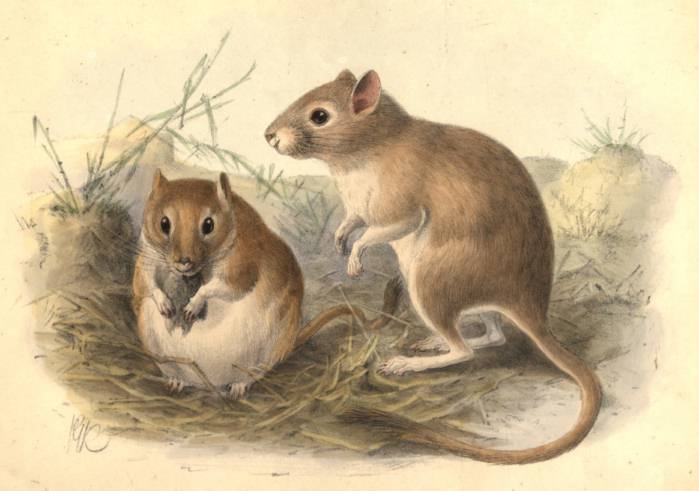This article originally appeared in the NGS Journal, The
Nibbler.

This illustration is a hand-coloured 19th Century engraving by the famous
bird illustrator J G
Keulemans (1842-1912).
Initially I was a little confused by the print because it is captioned “Gerbillus
cryptorhinus”. After some research I discovered that this is an obsolete name
for The Midday Gerbil which is now classified as Meriones meridianus. I
also discovered that the print was produced for a book published by the Indian
Government in 1879 called "The Scientific Results of the Second Yarkand
Mission: Mammalia" by William Thomas Blanford. Yarkand is a city on the
Silk Road, and is now in the Western most part of China. It is not far from
Kashmir and several embassies were sent to the semi-independent Amir of Yarkand
in the 19th Century.
The Midday Gerbil (Meriones meridianus) is a gerbil of similar size and
appearance to The Mongolian gerbil (M. unguiculatus) that we normally keep as a
pet. They live in some of the same areas but have a much larger range than the
Mongolian Gerbil. Midday Gerbils are common in sandy areas from Mongolia and
Northern China, right across as far west as the Caspian Sea and the River Volga.
This species looks almost the same as the Mongolian Gerbil. The main
differences are that the Midday Gerbil has light claws instead of the almost
black claws of the Mongolian Gerbil, and their belly fur is clearly white. Wild
Mongolian Gerbils have greyish belly fur which has been eliminated by selective
breeding from the domestic gerbils we have now.
Midday Gerbils live in a variety of dry habitats but their favourite type of
terrain is sandy desert with a regular covering of bushes. In some regions they
will even live in sand dunes. This is quite rare for gerbils and there are only
a few species that will live on shifting sands. In fact, Midday Gerbils appear
to be the most sand loving of all the gerbils of the genus Meriones. Whilst
there are Gerbils of other genera that live in these sorts of habitats, most
Meriones gerbils can only live where the ground is firm enough to burrow in
easily. Unlike many desert gerbils Midday Gerbils tend not to cluster around
oases. In the pasture on the edges of oases they are common rodent, but in the
cultivated areas where water is more plentiful, other rodents predominate.
Midday Gerbils will eat a large range of vegetation and will also eat insects
when they are available. They are known to destroy tree seedlings and are
considered a menace in areas where afforestation is being attempted to reduce
desiccation of the soil. They are also considered a pest in many areas because,
like many gerbils, their parasites include disease carrying fleas.
In general they live much like Mongolian Gerbils. They live in colonies in a
burrow system and stay active all year round. The entrance to the burrow is
often placed beneath a bush where that is possible. There are some significant
differences from Mongolian Gerbils though. Midday Gerbils dig burrows that are
much more complex than those of Mongolian gerbils. In the spring nearly all
adult females have at east one litter. Following the dry period in the middle of
Summer when breeding ceases, there is an autumn breeding period when only a
small number of females mate. They seem to be capable of breeding all year round
given moderate temperatures and a year round supply of food and water. But in
the wild this is not possible. Breeding starts in March in most regions and is
complete by early Autumn. Litters of between one and nine pups are known but on
average a litter consists of between five and six pups.
Although I cannot find any information on their predators, I would expect
that like Mongolian Gerbils they are preyed upon mainly by birds such as owls.
They seem to have very short life expectancy. One study found that they were
very effective at replacing the population. Whilst nearly all Midday Gerbils
trapped in April are adults, 85% of those trapped in September are juveniles.
References:
THE MAMMALS OF CHINA AND MONGOLIA: Part 2, Allen, G.M, The American Museum of
Natural History, New York, 1940, Pages 781-793
LIST OF MAMMALIA COLLECTED BY THE LATE DR STOLICZKA WHEN ATTACHED TO THE
EMBASSY UNDER SIR D FORSYTH IN KASHMIR, LADÁK, EASTERN TURKESTAN, AND WAKHÁN,
WITH DESCRIPTIONS OF NEW SPECIES: Blanford W T, 1875, Journal of the Asiatic
Society of Bengal, 44(2)
SCIENTIFIC RESULTS OF THE SECOND YARKAND MISSION: MAMMALIA, Blanford W T,
Office of the Superintendent of Government Printing - Calcutta, 1879
A REVISION OF THE GENUS MERIONES: Chaworth-Musters, J.L. and Ellermann, J.R.,
1948, Proceedings of the general meetings for scientific Zoological Society,
1243, Pages 478-504
ECOLOGY OF DESERT RODENTS OF THE USSR (JERBOAS AND GERBILS): N P Naumov, V S
Lobachev, 1975, Published as Chapter XXIII of RODENTS IN DESERT ENVIRONMENTS,
Prakash, L and Gosh, P.K. (volume editors), Dr W. Junk b.v. Publishers, The
Hague, ISBN 90 6193 080 4
There is a photo of the Midday
Gerbil here.




























Return to the NGS Homepage?
The views presented on this page are not necessarily those of the National
Gerbil Society.
Please note that the material on these webpages is covered by copyright law.
If you wish to use any pictures etc for anything other than your personal
private use, such as publishing material on a website, then
This web page may include links to other web sites. These links are provided
in order to enhance the interest and usefulness of other content and are not
intended to signify that the National Gerbil Society, or the authors of material
featured on the NGS Website, endorses or otherwise has any responsibility for
the content of any linked web page, web site or other linked material.
This page has been constructed by
Telephone number for media contact only - (+44)
07941893143
Last updated 22 September 2007

